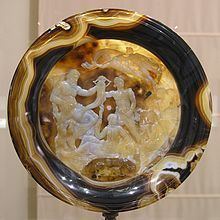 | ||
Similar Gemma Augustea, Farnese Bull, Gonzaga Cameo, Cup of the Ptolemies, Drunken Silenus | ||
The Farnese Cup (Tazza Farnese) is a 2nd-century BC cameo cup of Hellenistic Egypt in four-layered sardonyx agate. It is 20 cm wide.
Contents
History
After Octavian's conquest of Egypt in 31 BC, the Farnese Cup was acquired by the Treasury of Rome. It was later brought to Byzantium, then back west after this city was sacked in 1204 during the Fourth Crusade. By 1239 it was in the court of Frederick II, from which it then reached the Persian court of Herat or possibly Samarkand, where a contemporary drawing documents it; thence it found its way to the court of Alfonso of Aragon in Naples, where Angelo Poliziano saw it in 1458. Lorenzo the Magnificent finally purchased the famous "scutella di calcedonio" in Rome, in 1471. From there it came into the possession of the Farnese family through Margaret of Austria and thus into the Naples National Archaeological Museum
Iconography
It is a phiale (libation plate), though without the handles normal to the type. The internal decoration is an elaborate allegory of Ptolemaic Egypt's prosperity. It operates on two levels, one Egyptian, the other Greek.
It presumably represents the Egyptian divine triad, Serapis-Isis-Harpocrates or, alternatively, the Eleusinian triad: Hades/Pluto-Demeter-Triptolemos.
On the bottom are female figures possibly personifying the seasons. Two male figures soaring in flight above the divine triad represent the propitious Etesian winds that blow during the summer. On the exterior, a large apotropaic Gorgonian mask glares threateningly at the enemies of the state.
Produced at the court of the Ptolemies, other interpretations of the figures have them being Cleopatra III, her husband Ptolemy VIII and their son Ptolemy X Aléxandros. Through the amalgamation of Egyptian and Greek deities and their identification with members of the royal family, this dynasty tried to perpetuate the traditional conception of divine power they had inherited from pharaonic Egypt.
